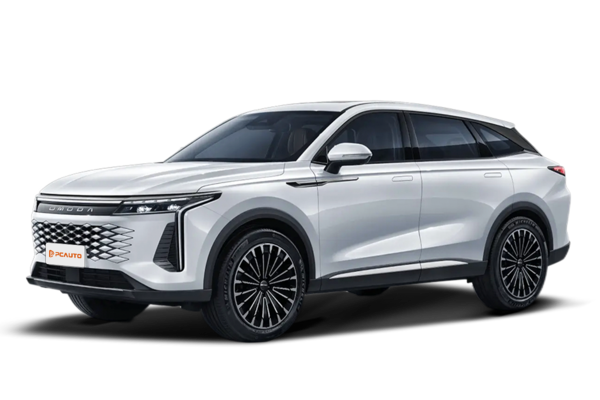Q
Is the Omoda C9 an electric vehicle?
The Omoda C9 is not an electric vehicle. It runs on gasoline, powered by a 2.0-liter turbocharged four-cylinder petrol engine. This engine delivers a maximum output of 261 PS and peak torque of 400 N·m, paired with an 8-speed automatic transmission. The model offers two drivetrain options: front-wheel drive (2WD) and all-wheel drive (4WD).
For those who prefer traditional internal combustion engines, this powertrain configuration achieves an excellent balance between performance and driving dynamics. While electric vehicles are gaining popularity, the Omoda C9 is a good choice for consumers who still value the reliability and power delivery characteristics of gasoline engines.
Special Disclaimer: This content is published by users and does not represent the views or position of PCauto.
Related Q&A
Q
Which segment is the Omoda C9 in?
The Omoda C9 belongs to the D-segment vehicle category. In terms of dimensions, it measures 4,775 mm in length, 1,920 mm in width, 1,671 mm in height, with a wheelbase of 2,800 mm - specifications that qualify it as a D-class vehicle. Such large dimension not only create a more spacious interior space for enhanced occupant comfort, but also give the vehicle a more substantial and sophisticated exterior presence. D-class vehicles typically represent elevated standards of quality and performance. The Omoda C9 shows this segment's advantages through its comprehensive safety package including eight airbags and multiple active safety systems, with premium comfort features such as power-adjustable seats and an expansive touchscreen display. These features align perfectly with D-segment positioning, delivering a high-end driving experience to consumers.
Q
What's the size of the wheels of Omoda C9?
The Omoda C9 is equipped with 20-inch alloy wheels fitted with 245/50R20 tires on both front and rear axles. This tire specification is relatively common - the number 245 indicates the tire width in millimeters (with wider tires generally providing greater contact area and improved grip), while 50 represents the aspect ratio (the tire's sidewall height as a percentage of its width, with lower values indicating a "lower profile" tire that typically enhances handling at a slight compromise to ride comfort). The "R" denotes radial tire construction, and 20 signifies the 20-inch wheel diameter.
The larger wheel size significantly enhances the vehicle's visual appeal, giving it a more athletic and substantial appearance. Furthermore, properly specified tires play a crucial role in various performance aspects including handling, braking, and driving stability, enabling the vehicle to adapt to diverse road conditions and driving requirements.
Q
What's the size of the engine of the Omoda C9?
The Omoda C9 is powered by a 2.0-liter engine, specifically the 2.0TGDI 400T model, adopting turbocharged intake and an inline four-cylinder configuration. This engine delivers a maximum power output of 192 kW and peak torque of 400 N·m, delivering an impressive 261 horsepower. Its robust power delivery ensures excellent performance whether accelerating in urban driving or overtaking on highways.
Paired with an 8-speed automatic transmission, the powertrain provides smooth gear shifts that further enhance the driving experience. This engine specification gives the Omoda C9 competitive advantages in its segment, effectively meeting drivers' demands for dynamic performance.
Q
What's the trunk capacity of the Omoda 9?
The trunk capacity of the Omoda 9 is 660L, which adequately meets the demands of daily commuting and family use. Whether for routine shopping, loading luggage, or transporting sports equipment, it provides high convenience. Such trunk capacity not only facilitates travel but also enhances the vehicle's practicality. The rear seats of the Omoda 9 support a 60/40 split-folding function, allowing partial or complete folding to expand cargo space when transporting bulky items like furniture or bicycles. This design offers greater flexibility to accommodate diverse loading scenarios.
Q
What is the Ancap rating of the Omoda C9?
At present, there is no specific ANCAP rating information about the Omoda C9. However, judging from the vehicle's configuration, it is well-equipped with comprehensive safety systems, including standard ABS anti-lock brakes, electronic stability control, lane change assist, lane departure warning, autonomous emergency braking, and eight airbags (driver, front passenger, front side, front/rear curtain, and knee airbags), along with ISOFIX child seat anchors.
Typically, vehicles with such comprehensive safety configurations have a good chance of achieving good ratings in ANCAP and similar safety assessments. For the most accurate Omoda C9 ANCAP rating, it's recommended to pay attention to official announcements from ANCAP.
Q
What color is the Chery Omoda C9?
Sorry, there is no information about the color of the Chery Omoda C9, so I can't provide an accurate answer. Generally, there is a wide variety of color options for vehicles. Common basic colors include black, white, and gray. Black appears calm and dignified, white is simple and clean with high visibility at night, while gray is understated and dirt-resistant. There are also some distinctive colors, such as red, which shows vitality and passion, and blue, which exudes a sense of technology. If you'd like to learn about the specific color options for the Chery Omoda C9, I recommend visiting your local Chery dealership or checking Chery's official website and social media channels for detailed information on the model's available colors.
Q
What is the range capability of Omoda C9?
The range capability of the Omoda C9 varies across different versions. For the gasoline-powered model with a 65L fuel tank, while official range figures haven't been specified, practical estimates suggest approximately 500-700 km under mixed driving conditions based on the fuel consumption characteristics of its 2.0T turbocharged engine.
The plug-in hybrid variant offers a combined range of 1,500 km with up to 240 km of pure electric range. This performance level can meet requirements for both daily urban commuting and long-distance travel. The gasoline version suits users concerned about charging infrastructure availability, while the PHEV model addresses range anxiety while delivering energy efficiency - allowing buyers to select their preferred version according to individual needs and usage patterns.
Q
What engine is the Omoda C9 equipped with?
The Omoda C9 is equipped with a 2.0L four-cylinder turbocharged gasoline engine with a displacement of 1998 mL. The engine delivers a maximum horsepower of 261 PS (192 kW) and a peak torque of 400 N·m, adopting an inline (Inline-L) cylinder configuration. This powertrain provides powerful output, enabling easy acceleration in urban driving and effortless overtaking on highways. Paired with an 8-speed automatic transmission, it ensures efficient power delivery while offering smooth gear shifts for enhanced driving comfort. Both two-wheel drive and four-wheel drive variants adopt this engine platform, catering to diverse consumer needs for vehicle performance and usage scenario.
Q
What is the fuel efficiency of the Omoda C9?
At present, there is no official data about the fuel economy of the Omoda C9. However, the Omoda C9 is equipped with a 2.0L four-cylinder turbocharged gasoline engine paired with an 8-speed automatic transmission. Generally speaking, the fuel efficiency of such a powertrain configuration is influenced by various factors, such as driving habits, road conditions, and vehicle load. If the driving style is smooth, with a little of sudden acceleration or braking, and the vehicle is primarily driven on well-maintained roads, its fuel efficiency may be better; conversely, aggressive driving with frequent stops and starts will negatively impact fuel efficiency. Vehicles with different drivetrain configurations also vary in curb weight, which further affects fuel efficiency. The 2WD model weighs 1,786 kg, while the AWD model weighs 1,876 kg. The relatively heavier AWD variant may theoretically consume more fuel.
Q
What's the dimension of the Omoda C9?
The Omoda C9 measures 4,775 mm in length, 1,920 mm in width, and 1,671 mm in height, with a wheelbase of 2,800 mm. These dimensions place the Omoda C9 in the D-segment SUV category. The Omoda C9 offers spacious interior. Its long wheelbase provides ample legroom for passengers, especially those in the rear seats, enhancing overall comfort. The substantial width ensures sufficient shoulder room, preventing any sense of crowding.
The large dimension also ensure a spacious 660-liter trunk capacity, easily accommodating daily needs and long-distance travel requirements. Whether loading multiple suitcases or bulkier items, the Omoda C9 delivers practical storage solutions.
Latest Q&A
Q
What is the difference between the 2024 and 2025 BMW 5 Series?
There are some differences between the 2024 and 2025 BMW 5 Series models. In terms of pricing, the 2024 520i starts at RM 332,800, with the 520i M Sport variant coming in at RM 349,800. The 2025 530i M Sport, on the other hand, is priced at RM 399,800.
Under the hood, the 2024 520i engines deliver either 210PS or 208PS, while the 2025 530i M Sport ups the ante with a 258PS powerplant. Performance-wise, the 2024 models top out at 230km/h and sprint from 0-100km/h in 7.5 seconds. The 2025 model pushes that top speed to 250km/h and shaves the 0-100km/h time down to just 6.2 seconds.
Looking at the specs, some 2024 trims have rear seats with manual adjustments or fixed configurations, whereas the 2025 model gets a 40:20:40 split-folding rear seat setup. Audio systems also see an upgrade: most 2024 models feature Harman Kardon speakers, while the 2025 model steps up to a Bowers & Wilkins surround sound system.
Additionally, the 2025 5 Series hit dealerships on March 13, 2025, and comes with a 2-year unlimited mileage warranty. The 2024 models first arrived on September 2, 2024.
Q
How much is insurance for a 2024 BMW 5 Series?
The insurance cost for the 2024 BMW 5 Series in Malaysia varies based on several factors, typically ranging from RM5,000 to RM15,000 annually. The exact amount depends on the vehicle model (such as 520i, 530e, or M550i), engine displacement, the owner's age, driving record, type of policy (comprehensive or third-party), and the insurance company's discount policies. For instance, the high-performance M550i, with its higher repair costs, will have significantly higher premiums than the entry-level 520i, while the hybrid 530e may qualify for partial insurance discounts due to its eco-friendly features. Additionally, Malaysia's insurance market is influenced by the No Claim Discount (NCD), where drivers with consecutive claim-free years can enjoy a maximum 55% reduction in premiums. It's advisable to obtain accurate quotes through insurance company websites or comparison platforms before purchasing a car, and also to understand the additional services offered by Malaysian car insurance, such as roadside assistance or windscreen coverage, as these details can impact the final decision. Notably, luxury car insurance usually includes higher third-party liability coverage limits to comply with local regulatory requirements, and owners can also adjust the excess amount according to their needs to balance premium costs.
Q
What is the maintenance cost of a 2024 5 Series?
The maintenance costs for the 2024 BMW 5 Series in Malaysia can vary depending on the specific model and driving habits, but generally speaking, the regular servicing fees for the first 3 years of a new car are roughly between RM3,000 to RM5,000 per year. This depends on the chosen original maintenance package and the actual mileage driven. BMW offers various maintenance plan in Malaysia, allowing owners to opt for one-time payment or installment plans. These packages typically cover basic items like oil changes, filter replacements, and brake inspections. If the vehicle is equipped with more high-tech features, such as active suspension or a hybrid system, the long-term maintenance costs might be slightly higher. However, BMW's after-sales service network in Malaysia is quite comprehensive, with many authorized service centers capable of providing professional maintenance and repair services. To reduce long-term ownership costs, it's advisable for owners to follow the manufacturer's recommended regular maintenance schedule and use genuine parts. This not only extends the vehicle's lifespan but also helps maintain a good resale value. Additionally, given Malaysia's hot and humid climate, owners should pay extra attention to maintaining the air conditioning system and battery to ensure the vehicle always stays in optimal condition.
Q
How much is a used BMW 5 Series 2024?
In the current Malaysian market, used 2024 BMW 5 Series models aren't widely available yet due to the new car's relatively recent launch. However, based on the market trends for used BMW 5 Series of similar model years and conditions, prices typically range from RM250,000 to RM350,000. The exact price depends on factors like trim level, mileage, maintenance history, and whether the original factory warranty is still valid. For instance, higher-spec models like the 530i M Sport might be closer to the upper end of that range, while entry-level variants such as the 520i would be relatively lower. When buying a used car, it's advisable to go through officially certified pre-owned channels or reputable dealerships to ensure the vehicle has undergone rigorous inspection and comes with warranty coverage. Additionally, the BMW 5 Series is renowned for its luxurious interior, advanced technology, and driving dynamics – the 2024 model, in particular, likely features the updated iDrive system and mild-hybrid technology, which also influence used prices. In Malaysia, used car prices can also be affected by import duties, road tax, and insurance costs, so it's recommended to thoroughly assess the total cost of ownership and compare different car sources to get the best value for money before making a purchase.
Q
How many BMW 5 Series sold in 2024?
As of 2024, official sales figures for the BMW 5 Series in Malaysia haven't been formally released yet. But looking at BMW Malaysia's past market performance and industry trends, this luxury sedan has always maintained steady demand locally, especially thanks to its blend of sporty performance and business luxury that really resonates with local buyers. For 2024, the BMW 5 Series has rolled out more eco-friendly powertrain options, like plug-in hybrid models, which should further appeal to buyers who want both efficiency and high performance. In the Malaysian market, luxury car sales are usually influenced by the economic environment, consumption tax policies, and brand promotional activities. Interested consumers are advised to follow BMW Malaysia's official website or authorized dealers for the latest and most accurate information. Additionally, as a representative of mid-size luxury sedans, the BMW 5 Series competes with models like the Mercedes-Benz E-Class and Audi A6, which also have a strong presence in the Malaysian market. Consumers can make a comprehensive comparison based on personal preferences and budget.
View MoreRelated News

Chery launched a car that can drive on water, JETOUR Zongheng G700 unveiled
MichaelOct 22, 2025

The Tiggo 7 PHEV, conversely, gains traction among younger buyers by offering a lower price point and a more technologically advanced package.
JamesOct 15, 2025

Chery successfully listed on the Hong Kong Stock Exchange, which may accelerate its globalization in the future?
JamesSep 26, 2025

Chery Tiggo Cross launched in Malaysia 1.5T and hybrid model analysis, a new compact SUV option starting from 88,000
JamesSep 12, 2025

Omoda 5 facelift model Omoda O5 open for pre-order, transmission upgraded to DCT
MichaelSep 3, 2025
View More












 Cars
Cars




Pros
Cons